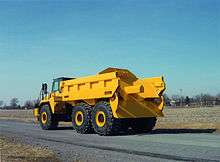Rear-eject haul truck bodies

Rear-Eject Haul Truck Bodies are an alternative haul truck body style developed for quarry, road-building, steel mill, landfill and underground mining applications. Instead of lifting the bed vertically, the hydraulic cylinder pushes a ram-face horizontally through the body to eject the hauled load.[1]
History
Rear-eject dump vehicles were first introduced in the 1980's by LeRoy Hagenbuch, P.E. of Philippi-Hagenbuch, Inc. for a refuse hauling application in New York City. They were designed to work on Volvo BM truck chassis. While the functionality of the ejector bodies worked well, they were prone to maintenance issues and not replicated until the 1990s. The next documented ejector bodies were developed by DDT, a UK truck manufacturer.[2] A variation using steel chains instead of a hydraulic ram was introduced by Bell, but did not become popular.[3]
Caterpillar Inc. began offering a rear-eject option using technology originally designed for its scrapers after one of its contractors successfully converted a few CAT D400 models. The new design, installed on the company's D400E model, was less likely to jam in cold weather.[3] CAT later began manufacturing a standard R.E. body for its 730, 740, and 740B articulating haul-truck series.[4]
Philippi-Hagenbuch, a company specializing in truck body design, developed its own mechanism for its rear-eject bodies, and has patented its design in the USA, Europe and Australia.[1] The company customizes Rear-Eject bodies or trailers for several manufacturers' off-highway vehicles; including both rigid and articulating varieties.[5]
As of 2014 Caterpillar Inc. and Philippi-Hagenbuch, Inc. are continuing to manufacture Rear-Eject bodies for off-highway applications,[1] each using its own design of mechanism.
Rear-Eject vs. End-Dump Bodies
Because rear-eject bodies do not lift, or move externally in any way, they maintain a lower center of gravity. This means more stability on uneven terrain where the truck might tip over during the dump process. The truck can also be driven while dumping is in progress; this reduces subsequent time and effort spent on grading the dumped material.[6]
Rear-ejects are typically better suited to completely eject sticky material, preventing "carry-back."[3]
A rear-eject truck can deliver a load in an area with a low overhead barrier.[7]
References
- 1 2 3 "Rear-eject dumpbodies". World Highways. January–February 2013. Retrieved 2014-09-15.
- ↑ Woof, Mike. "ADT versatility makes trucks a popular choice". Aggregates.
- 1 2 3 Mike Woof. Ultra Haulers. MotorBooks International. pp. 125–. ISBN 978-1-61059-236-9.
- ↑ Australian Journal of Mining: AJM. General Magazine Company. January 2002.
- ↑ "Combination rear eject/end dump bodies for scrap ". Recycling Product News
- ↑ "Komatsu ADT with rear eject body - performs well at Namakwa Sands operation". Quarrying, October 2008.
- ↑ Moore, Paul. "Material Progress". InfoMining.